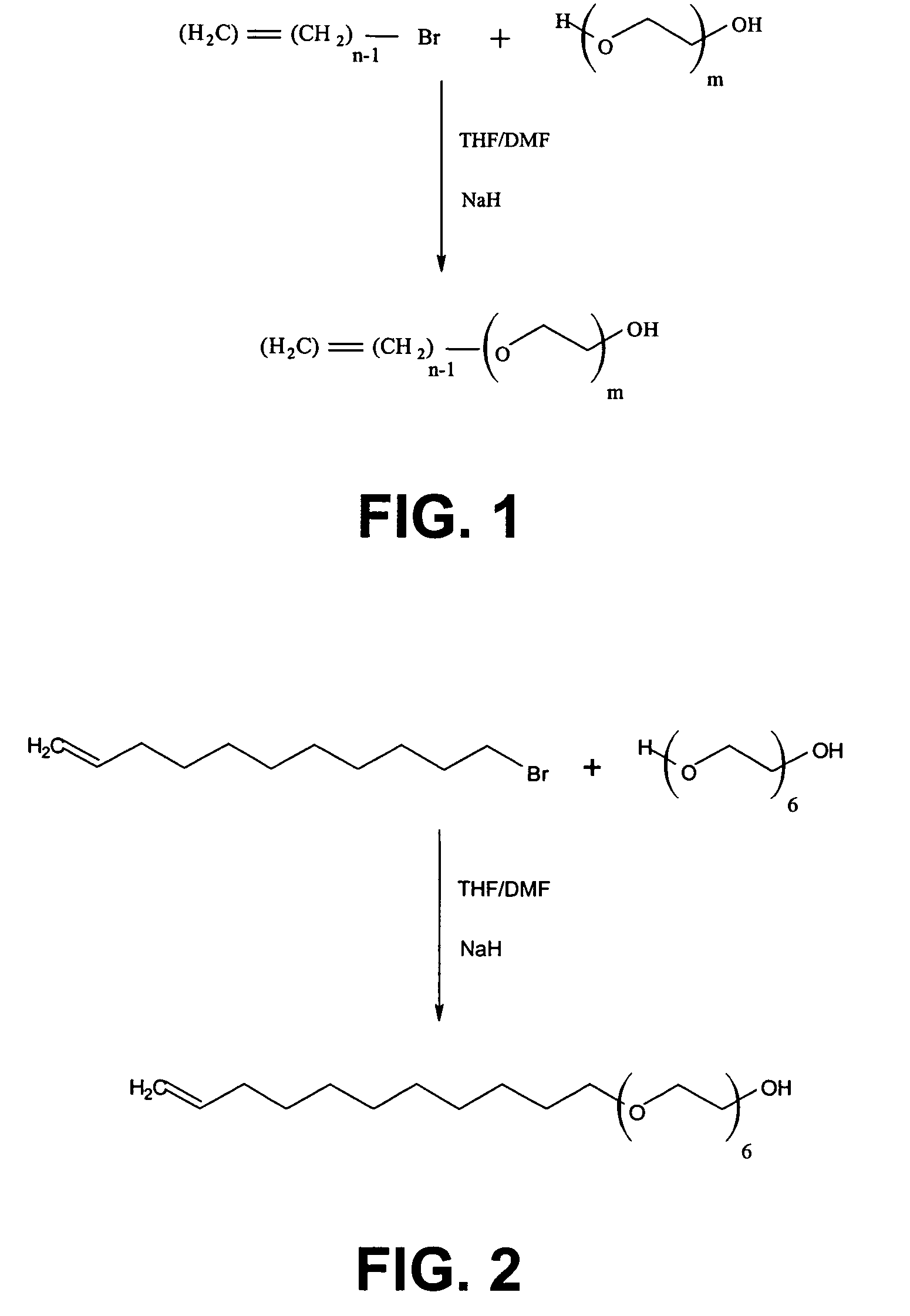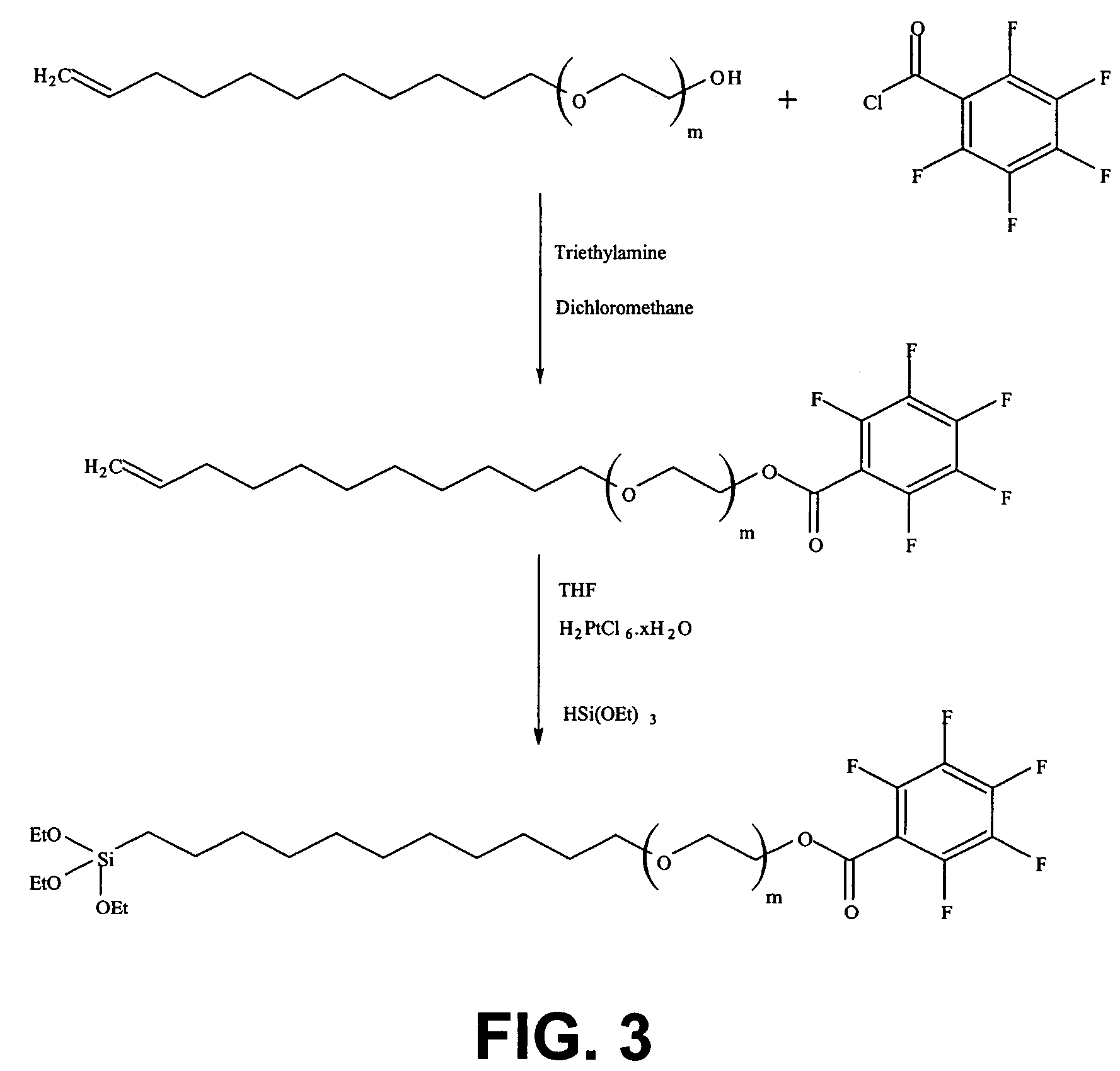Silane molecules with pre-activated and protein-resistant functionalities and silane films comprising such molecules
a technology of silane molecules and functionalities, which is applied in the field of silane molecules, can solve the problems of high sensitivity imposing more severe demands on the immobilisation of such biological sensing elements, dna films are susceptible to removal from the surface, and affinity biosensors are not yet commercially available, so as to reduce steric hindrance, enhance protein resistance, and reduce sensitivity
- Summary
- Abstract
- Description
- Claims
- Application Information
AI Technical Summary
Benefits of technology
Problems solved by technology
Method used
Image
Examples
example 1
Synthesis of triethoxy-(11-{2-[2-(2-{2-[2-(2-ethoxy)-ethoxy]-ethoxy}-ethoxy)-ethoxy]-ethoxy}-2,3,4,5,6-pentafluorbenzoate)-silane
[0156]The silane according to the first example has a general formula as in formula (1) with X=OEt3 and with Y=a fluor substituted benzoate, more particular 2,3,4,5,6 pentafluorbenzoate. The synthesis route for the silane of Example 1 is illustrated in FIG. 3. The synthesis route will be described starting from molecule A and with thus m=6 and n=11. It has to be understood that similar molecules can also be obtained starting from molecule A (see formula 2) having another value for m or n.
Method
Step 1
[0157]In a dry two neck bottle which comprises a magnetic stirrer and under argon atmosphere, 1 equivalent of molecule A (m=6) is dissolved in CH2Cl2.[0158]˜1-5 equivalents of triethylamine (Et3NH2) are then added and the solution is stirred for 20 minutes.[0159]2 equivalents of pentafluorbenzoylchloride (CAS: 2251-50-5) are added and the solution is stirred ov...
example 2
Synthesis of Triethoxy-(11-{2-[2-(2-{2-[2-(2-ethoxy)-ethoxy]-ethoxy}-ethoxy)-ethoxy]-ethoxy}-perfluorophenyl acetate)-silane
[0200]The silane according to the second example has a general formula as in formula (1) with X=OEt3 and with Y=a pentafluorphenyl ester. The synthesis route for the silane of Example 2 is illustrated in FIG. 4. The synthesis route will be described starting from molecule A and thus with m=6 and n=11. It has to be understood that similar molecules can also be obtained starting from molecule A having another value for m and n.
Method
Step 1
[0201]In a dry three neck bottle comprising a magnetic stirrer and being under argon atmosphere, 1 equivalent of molecule (m=6) is, together with a small excess of NaH, dissolved in DMF / THF.[0202]The solution is stirred for 50 minutes.[0203]˜1.2 equivalents of tert-butyl bromoacetate (CAS: 5469-26-1) is added dropwise and the solution is stirred overnight at room temperature.[0204]THF and DMF are then removed at the rotavap.[020...
example 3
Synthesis of Triethoxy-(11-{2-[2-(2-{2-[2-(2-ethoxy)-ethoxy]-ethoxy}-ethoxy)-ethoxy]-ethoxy}-perfluorophenyl acetate)-silane
[0221]The silane according to the third example has a general formula as in formula (1) with X=OEt3 and with Y=a pentafluorphenyl ester. The difference with Example 2 is that now the spacer is a single heteroatom. The synthesis route for the silane of Example 3 is illustrated in FIG. 5. The synthesis route will be described starting from molecule A and thus with m=6 and n=11. It has to be understood that similar molecules can also be obtained starting from molecule A having another value for m and n.
Method
Step 1
[0222]In a dry three neck bottle comprising a magnetic stirrer and being under argon atmosphere, 1 equivalent of molecule A (m=6) is dissolved in DMF / THF and the solution is stirred for 50 minutes.[0223]˜1.2 equivalents of pentafluorphenylcarbonate (Molecular biosciences 60008) are added dropwise and the reaction mixture is stirred overnight at room temp...
PUM
| Property | Measurement | Unit |
|---|---|---|
| diameter | aaaaa | aaaaa |
| diameter | aaaaa | aaaaa |
| temperature | aaaaa | aaaaa |
Abstract
Description
Claims
Application Information
 Login to View More
Login to View More - R&D
- Intellectual Property
- Life Sciences
- Materials
- Tech Scout
- Unparalleled Data Quality
- Higher Quality Content
- 60% Fewer Hallucinations
Browse by: Latest US Patents, China's latest patents, Technical Efficacy Thesaurus, Application Domain, Technology Topic, Popular Technical Reports.
© 2025 PatSnap. All rights reserved.Legal|Privacy policy|Modern Slavery Act Transparency Statement|Sitemap|About US| Contact US: help@patsnap.com



